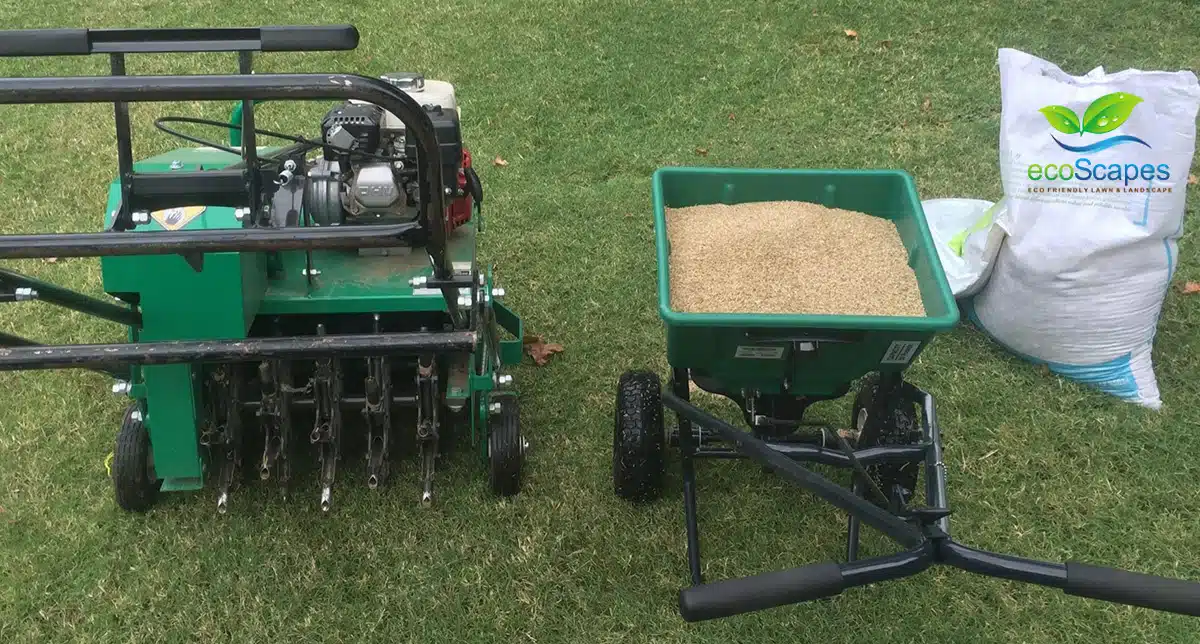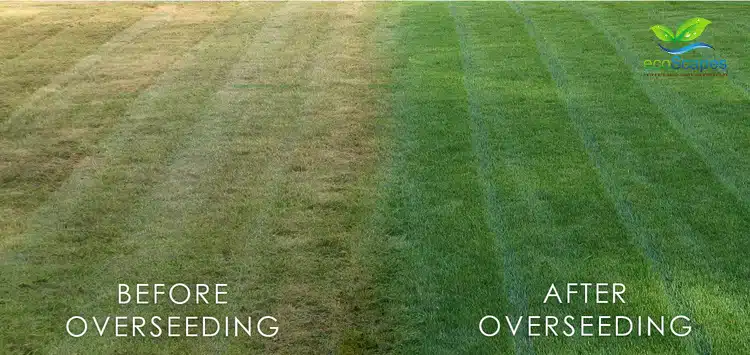
14 Jul How to Prepare Your Yard for Lawn Aeration and Overseed
Updated 4/19/2023
How to Prepare Your Omaha Yard for Lawn Aeration and Overseeding This Fall
Autumn is synonymous with earthy tones, hoodies, and pumpkin-flavored sweets. It’s also well-known as the best time of the year to aerate and overseed your lawn.
After a scorching summer, all that cool weather translates to ideal growing conditions for your lawn. The most essential things to concentrate on in the fall are repairing any damage from July and August, preparing for the winter, and preparing your grass for a lush spring. There are several things you can do for your lawn this time of year, but none offer the many benefits of lawn aeration.
In this article, we are going to focus on preparing your lawn for aerating and overseeding.
At the very least once a year, your turf should be aerated and overseeded. Preparing your lawn for aeration and overseeding can help you finish the growing season strong and get your yard ready for next year.
Let’s take a look at the best ways to get your lawn ready for fall aeration.
3 Steps to Prepare for Fall Lawn Aeration and Overseeding in Omaha
There are a few things you can do to prepare your lawn for aeration and overseeding. To begin, mowing your grass at a lower height is strongly recommended. Then, any objects or buildings that may be in the way of the aerator should be marked, and finally, watering should be adjusted to ensure that the soil is neither too wet nor too dry.
Let’s go over the process in greater depth.
Step 1: Mow Your Lawn Shorter Than Usual
You should start mowing your grass a little shorter a few weeks before aeration and seed planting. Most grasses in Nebraska thrive when they are managed at a height of no less than 3 1/2 inches. However, in the fall, we recommend cutting your grass to a height of 3 inches or less.
There are two reasons why we advise homeowners to do so. For starters, shorter turf will make it easier for seed and fertilizer to reach the soil and make direct contact with it. Second, it is suggested that no mowing be done for at least three to four weeks following aerating and overseeding. Reducing the height of your grass can help you get better results when it’s aerated, and it’ll save you from having a forest outside your house as the grass grows in the days after.
It is preferable to lower the mower blades in phases rather than all at once to reduce the stress that the lower height may create. Cutting too much grass at once can be harmful to your lawn. Gradually lowering the mower blades over a period of a few weeks allows the grass to adjust to the decreased height.
Step 2: Adjust Your Watering Schedule
Watering your grass is a delicate job that is hard to master, especially when the weather changes often. Watering any cool-season grass over the summer months leading up to fall aeration and planting is critical for its health.
Aeration is difficult in hard and dry soils, and seed germination is nearly impossible. Before aerating your goal should be soft but not muddy or excessively mushy to walk on. Lawn aerators are very heavy and when there’s a lot of water in the yard, they can sink or cause ruts in the lawn.
Prepare your system to run three to five times a day after your seed is planted. Remember to moisten your fresh seed to ensure proper germination. Soaking can cause your seed to wash away.

Step 3: Flag Sprinkler Heads and any Obstacles
Because it is the only way to potentially avoid significant damage, this is arguably the most critical step in preparing your lawn for aeration.
Most core aerators penetrate the soil to a depth of three to five inches (depending on the moisture and nature of the soil). Because core aerators are strong and heavy equipment, any obstacles within five to six inches of the lawn’s surface may be damaged if not properly marked.
Most home supply stores provide flagging markers for marking your lawn.
Items linked with an irrigation system placed in the ground are one of the most typical obstacles in a lawn that need to be marked. Sprinkler heads, for example. Sprinkler heads are placed along the edge of the turf and possibly in the center of the lawn (it depends on the size of the lawn, as well as the layout of the irrigation zones). You must run each zone and set a flag next to the sprinkler heads to flag them. Sprinklers located within flowerbeds do not need to be marked. Only the objects that are within your yard’s perimeter. Take, for instance, a valve box.
Valve boxes are around the size of a plate and might be difficult to find. Check your lawn again, and any valve boxes you find should be marked on both sides.
Invisible fence lines for dogs (for dog training and keeping your pet in your yard), cables, wires, and pipelines are other items that should be marked. These may have been buried deep enough originally for and then revealed due to erosion. Underground dog fences, irrigation pipelines, lighting lines, and satellite cables are all examples of lines that can potentially be damaged.
Your lawn aeration and seeding provider cannot be held liable for any damages if they are unaware of a potential impediment on your lawn. If you’re having problems identifying these items in your yard, contact your lawn care provider in Omaha, and they may offer this as an extra service.
Aeration and overseeding in the early fall are crucial aspects of lawn upkeep, and there are actions that homeowners can do to ensure that the process goes well. Preparing for early fall aeration and overseeding may be accomplished by correct mowing, watering, and marking.
If you have any questions about how to prepare your lawn, contact our staff at EcoScapes Lawn Care.

